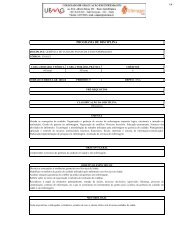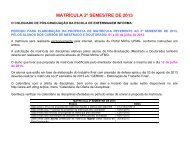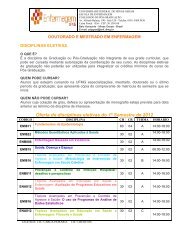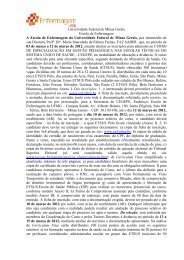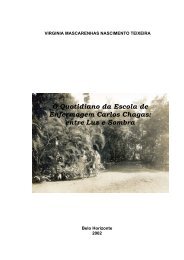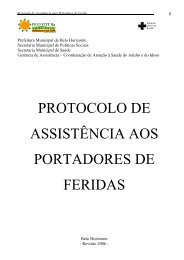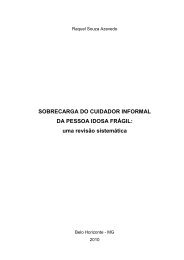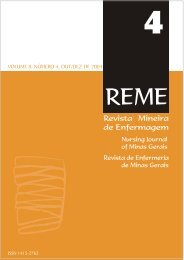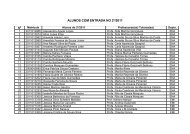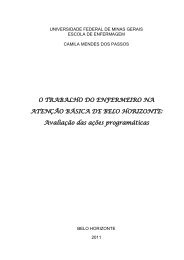Reme cap 00 v9 n3 - Escola de Enfermagem - UFMG
Reme cap 00 v9 n3 - Escola de Enfermagem - UFMG
Reme cap 00 v9 n3 - Escola de Enfermagem - UFMG
You also want an ePaper? Increase the reach of your titles
YUMPU automatically turns print PDFs into web optimized ePapers that Google loves.
Publication Norms<br />
1 - REME - Revista Mineira <strong>de</strong> <strong>Enfermagem</strong> is a publication of the School of Nursing of the Fe<strong>de</strong>ral University of Minas<br />
Gerais/<strong>UFMG</strong>, in partnership with Nursing schools and courses in the State of Minas Gerais, Brazil. The magazine is<br />
issued every quarter with the objective of contributing to the production, dissemination and use of the knowledge<br />
produced in nursing and other areas, covering issues related to teaching, research and assistance.<br />
2 - REME has the following structure: an Editorial; original articles, abstracts of theses and dissertations, reports<br />
of experience, updates and reviews; notes and information (updates in nursing and similar fields, research reports,<br />
abstracts and varied pieces of news); publication norms.<br />
3 - The papers are analyzed by the editors of REME, who have the right to accept or refuse the papers submitted.<br />
4 - The articles must be sent on a diskette, in "Word for Windows", version 6.0 or higher, "Times New Roman",<br />
size 12, double space, in two copies printed on standard ISO A4 paper (212x 297mm), with margins of 25mm,<br />
standard letter or laser, limited to 20 pages, including title, text, acknowledgements, bibliography, tables, legends<br />
and illustrations. They must be addressed to REME with a cover letter containing the name of the authors, mailing<br />
address, e-mail address, telephone and fax numbers.<br />
5 - The first page should contain the title of the paper; names of the authors, with their highest aca<strong>de</strong>mic qualification<br />
and institution; address for correspon<strong>de</strong>nce and financing agencies (in a footnote); abstract and key-words; the title,<br />
abstract and key-words should be in Portuguese, English and Spanish. The English and Spanish abstracts should come<br />
at the end of the paper, before the bibliography. The abstract should be no longer than 1<strong>00</strong> words.<br />
6 - The drawings and graphs should be presented on tracing paper; photographs and/or sli<strong>de</strong>s numbered and in black<br />
and White, indicating the place for insertion in the text; abbreviations, symbols, units and bibliography should follow<br />
international norms of publication.<br />
7 - For the purposes of normalization, we adopt the requirements of the International Committee of Medical Journal<br />
Editors. These norms can be found in full in the following publications: International Committee of Medical Journal.<br />
Editors: Uniform requirements for manuscripts submitted to biomedical joumals; Can. Assoc. J. 1995; 152(9):1459-65<br />
and in Spanish, in the Bol. Of Sanit. Panam. 1989, 107 (5).422-31.<br />
8 - All papers should have the following structure and or<strong>de</strong>r:<br />
• title (with translations into Portuguese and Spanish);<br />
• Complete name of author (authors), followed by their profession and respective qualifications;<br />
• Abstract in Portuguese, no longer than 1<strong>00</strong> words;<br />
• Key-words (three to tem), according to the Medical Subject Headings (MeSH) of the In<strong>de</strong>x Medicus;<br />
• text: introduction, material and method or <strong>de</strong>scription of methodology, results, discussion and/or comments<br />
and conclusions;<br />
• Summary in English (Abstract) and Spanish (Resumen), with the correct version for those languages;<br />
• Key words/ Palabras-clave (English and Spanish) according to the Medical Subject Headings I (MeSH) of the In<strong>de</strong>x<br />
Medicus; <strong>de</strong>scriptors of BIREME: www.bireme.br;<br />
• Acknowledgements (optional);<br />
• Bibliography, as specified in item 10;<br />
• Author’s address for correspon<strong>de</strong>nce.<br />
9 - Illustrations should be placed immediately after references to them in the text. Within each category, they should<br />
be numbered in sequence throughout the text. Example: (Tab. 1, Fig. 1, Graph 1). Each illustration should have a title<br />
and its source. Headings and legends should be sufficiently clear and comprehensible, without the need to consult<br />
the text. References to illustrations in the text should be mentioned between parenthesis, indicating the category<br />
and number of the illustration. Ex. (Tab. 1). Photographs should be black and White, coming in a separate envelope.<br />
They should be sharp and with good contrast, on glossy paper and, on the back, they must inclu<strong>de</strong>: author’s name,<br />
title of the article and number for inclusion in the text.<br />
10 - The bibliography references will be numbered in sequence, in the or<strong>de</strong>r in which they are mentioned in the text.<br />
They must follow the norms of the International Committee of Medical Journal Editors mentioned in item 7. The titles<br />
of the journals are abbreviated as in the In<strong>de</strong>x Medicus, in the publication "List of Journals In<strong>de</strong>xed in In<strong>de</strong>x Medicus",<br />
issued annually in January, in separate. The text references should be given in Arabic numbers, corresponding to the<br />
references at the end of the article. Bibliographical references should be quoted as follows:<br />
10.1 - JOURNALS<br />
a) Standard journal article. Inclu<strong>de</strong> the name of all the authors, when they are six or fewer. If they are seven or<br />
more, quote the fist three, followed by et al.<br />
Nascimento ES Compreen<strong>de</strong>ndo o cotidiano em saú<strong>de</strong>. Enf Rev 1995; 2(4):31-8.<br />
REME – Rev. Min. Enf.; 9(3): 279-286, jul./set., 2<strong>00</strong>5 •



